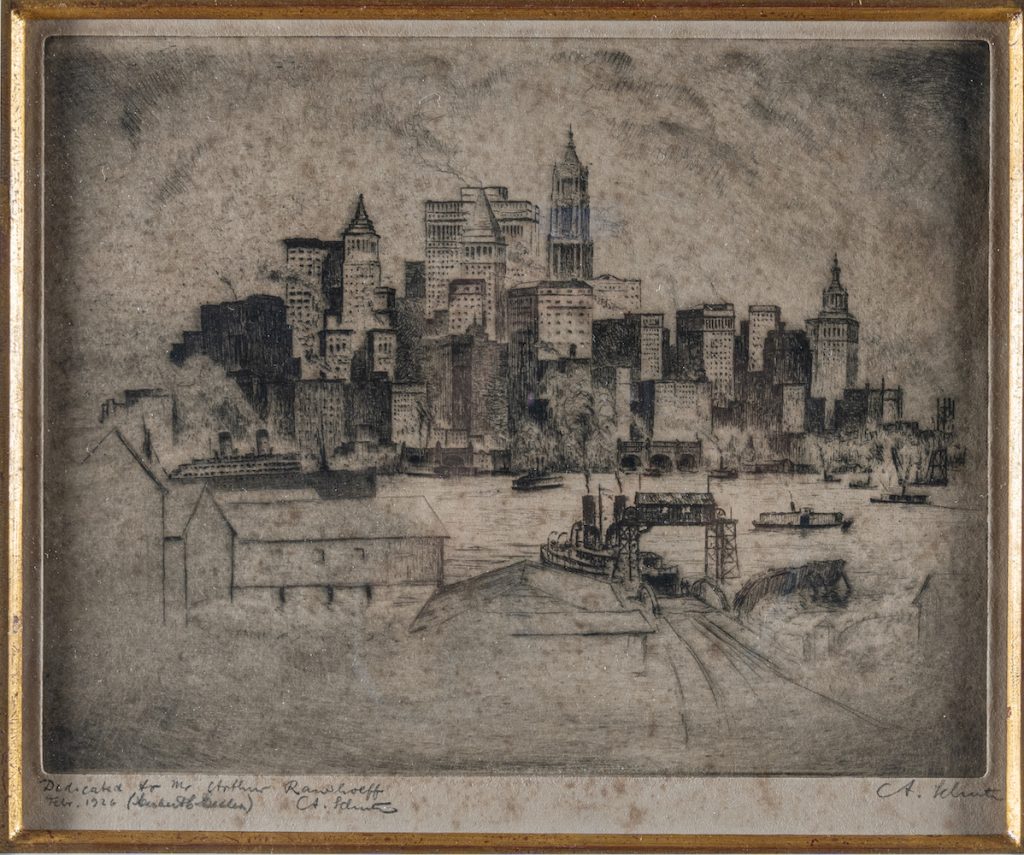Schütz Etching

This is an etching that captures the American spirit of the modern, growing metropolis that was New York City in 1926. The work, which shows the city from the shores of Governor’s Island, is by Anton Friedrich Josef Schütz, an artist and founder of the New York Graphic Society in 1925. He was born in Prussia in 1894 and died in NYC in 1977. He is known for his renderings of East Coast cityscapes and architecture, as well as for his publishing career in art books. This is a print, also called a “multiple.” Since this is an etching, I assumed I would find this image as one of a series, or edition, in the market. This image may be a monoprint; a similar work, titled The Old Guard, has old iron cannons in the foreground. Governor’s Island was “founded” under the British rule of Manhattan in 1664 and named for “the accommodation of His Majesty’s (William III) Governors” in 1699.
I found many similarities between Schütz and my grandfather, also an emigrant from Prussia. “Opa” came to NYC in 1923, Schütz in 1924. Schütz left Germany after a disappointing conscription into the German Army in WWI, though he served with distinction as a corporal in Flanders. A lifelong pacifist, when Schütz emigrated to the U.S. he destroyed all the copper plates he had etched in Germany.
Shortly after Schütz came to NYC in 1924, he etched “Governor’s Island” and many other NYC views. It is remarkable that in a few short years he had absorbed the progressiveness and grandeur of the “modern” NYC. Schütz was one of the early artists that made New York architecture a “brand”, visually speaking. In my Opa’s case, four years after emigrating to NYC, he began his own engineering business in elevators to serve those massive new buildings. In 1914 my grandfather (at 12 years old) had a job in an engraver’s shop; he later became a draughtsman. When I look at this image, I think of what my grandfather must have seen in the mid 1920s as an emigrant in that massive American metropolis, one he helped shape.
Schütz began his art studies in Munich, where he studied architecture, engineering, and art. At the art academy he studied copper plate etching. He put himself through school by selling etchings of traditional German architecture in the Munich galleries 1918-1922. Germany fell into an enormous economic crisis in 1923, and saw the early rise of the Nazi party under Hitler. Schütz’s apartment looked out over the Feldherrnhalle where Hitler led a violent attempt to overthrow the Weimar Republic in 1923. Schütz left after Christmas of 1923.
In NYC he was immediately successful selling his etchings of New York that emphasized the monumental scale of the architecture; the perspective was from across lengthy vistas devoid of people or automobiles, as if to portray the shining city with a sense of awe. Time Magazine invited Schütz to etch Moscow (and other great “modern” Soviet cities) in the newly formed USSR. He toured Russia and Europe in the late 1920s, and in 1928 was hired by Encyclopedia Britannica, the New York Times, and New York Magazine to etch reproductions of images. In 1925 he founded the New York Graphic Society, whose lavishly illustrated books would, by 1945, make them the world’s largest publisher of color reproductions. Throughout the 1920s and 1930s he focused on etching the architecture of Manhattan and Brooklyn, showing at NYC’s Anderson Gallery in 1924. In 1925, he was commissioned by the U.S. Chamber of Commerce to create 12 etchings commemorating the founding of New Amsterdam, and in 1930, he etched the great stock exchange buildings of the world.
With the onset of a new world war, in 1939 Schütz stopped making art. A book on his work – Anton Schütz: New York in Etchings – was published that year by Bard Brothers and focused on the Society he founded. His book Fine Art Reproductions: Old and Modern Masters has been through numerous reprintings since 1946, and is a history of reproduction techniques used in art and the different styles of prints (lithos, etchings, woodcuts…). The Society published many books between 1925 and 1966, his Complete Letters of Van Gogh taking an award in 1958. But perhaps the biggest honor came through the United Nations in 1949. He was asked by UNESCO to publish a World Art Series of books; a project that saw him touring the world from 1949-1961, documenting and cataloguing cross-cultural art for the U.N. His papers are housed at the Smithsonian, and he has artwork in the collection of the Uffizi and the National Gallery of Paris. The condition of the etching in question devalues it. It is worth $375.00.





